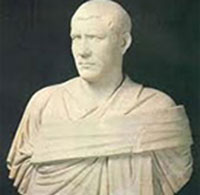Marcus Julius Philippus Augustus;( 204 – 249), also known as Philip or Philippus Arabs, was Roman Emperor from 244 to 249. He was born in present-day Syria in Shahba, about 55 miles southeast of Damascus, in the al-Swedaa governate, then a Roman province. Philip has the nickname “the Arab” because his family originated in the Arabian peninsula. he was the son of a Julius Marinus, a local Roman citizen. Many historians agree that he was of Arab descent and gained Roman citizenship through his father, a man of considerable influence. However, it is documented that Rome used the Ghassan tribe as vassals to keep the neighboring northern Arabs in check.
In 234, Philip married Marcia Otacilia Severa, daughter of a Roman Governor. They had two children: a son named Marcus Julius Philippus Severus (Philippus II) and a daughter called Julia Severina.
Philip became a member of the Praetorian Guard during the reign of the emperor Alexander Severus, who was a Syrian. In ancient Rome the Pretorian Guard was closely associated with the emperor, serving as the emperor’s bodyguard among other tasks. Then he acceded to the position of commander of the praetorians. In 25 February AD 244, Gordian III was killed, and the troops hailed him emperor of the Roman empire. The senators, with whom Philippus managed to establish a good relationship, thus confirmed him as emperor.
Philippus’ first act as emperor was to reach agreement with the Persians. After this agreement he understood the need to have trustworthy people in important positions, therefore put his brother Gaius Julius Priscus in charge of Mesopotamia. Back in Rome, his brother-in-law Severianus was granted the governorship of Moesia. He also secured imperial titles for his wife, Otacilia Severa, and his son, Philip II, thus laying the foundation for a new dynasty and giving the Roman people the hope of future stability. But most popular of all was Philip’s decision to hold a large millennial celebration in order to kindle hope in an anxious age.
 During his reign, Rome celebrated its millennium. To mark the occasion, Philip staged Ludi Saeculares (Centennial Games) in April, 1001 AUC[1] (AD 248), when Rome had actually completed its first millennium and embarked upon its second. Of all the many series of games that were staged in Rome, these Ludi were the greatest. In addition, Philip also sponsored some earlier celebrations to hasten the euphoria that many people wanted to feel—and that fueled his popularity. Some exotic members this millennial celebration can be seen today on Philip’s imperial commemorative coinage. Many coins declared SAECVLVM NOVVM (“The New Age”) and M1LIARIVM SAECVLVM (“The Millennial Age”). Some mintages projected the hope of better things to come with inspiring slogans like PAX AETERNA (“Eternal Peace”).
During his reign, Rome celebrated its millennium. To mark the occasion, Philip staged Ludi Saeculares (Centennial Games) in April, 1001 AUC[1] (AD 248), when Rome had actually completed its first millennium and embarked upon its second. Of all the many series of games that were staged in Rome, these Ludi were the greatest. In addition, Philip also sponsored some earlier celebrations to hasten the euphoria that many people wanted to feel—and that fueled his popularity. Some exotic members this millennial celebration can be seen today on Philip’s imperial commemorative coinage. Many coins declared SAECVLVM NOVVM (“The New Age”) and M1LIARIVM SAECVLVM (“The Millennial Age”). Some mintages projected the hope of better things to come with inspiring slogans like PAX AETERNA (“Eternal Peace”).
The oasis settlement now named, Shahba, had been the native hamlet of Philip the Arab. After Philip became the emperor of Rome in 244 CE, he dedicated himself to rebuilding the little community as a colonia (Roman colony), making it the last of the Roman cities founded in the East. The city was renamed Philippopolis (City of Philip) in dedication to the emperor. He wanted to turn his native city into a replica of Rome herself.
Philippopolis included an hexagonal-style temple and an open-air place of worship of local style, called a kalybe[2], a triumphal arch, baths, an unornamented theatre faced with basalt blocks, a large structure that has been interpreted as a basilica, and the Philippeion[3] surrounded by a great wall with ceremonial gates, were laid out and built following the grid plan of a typical Roman city.
Little is known about Philip’s early life and political career. But went on to become a major figure in the Roman Empire. He was to become known as ‘Philip the Arab’, the first man of that race to hold the Roman imperial throne.
Lama Alhassanieh
[1] Ab urbe condita (related to Anno Urbis Conditae: AUC or a.u.c. or a.u.) is a Latin phrase meaning “from the founding of the City (Rome)”, traditionally dated to 753 BC. AUC is a year-numbering system used by some ancient Roman historians to identify particular Roman years. Wikipedia
[2] A kalybe was a style of open-air temple found only in Roman Syria and Palestine. All known kalybes were built in the “Basalt Land” of Hauran. They are distinguished by their open structure in public squares, focusing on a large central niche containing a monumental statue. Kalybes were centers for the Roman imperial cult. They were a radical departure from traditional Greco-Roman temple design and are considered architecturally unique. Wikipedia
[3] The Philippeion in the Altis of Olympia was an Ionic circular memorial of ivory and gold, which contained statues of Philip’s family, Alexander the Great, Olympias, Amyntas III and Eurydice I. It was made by the Athenian sculptor Leochares in celebration of Philip’s victory at the battle of Chaeronea (338 BC). It was the only structure inside the Altis dedicated to a human. Wikipedia

